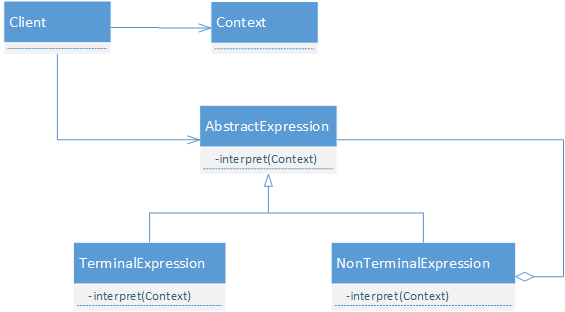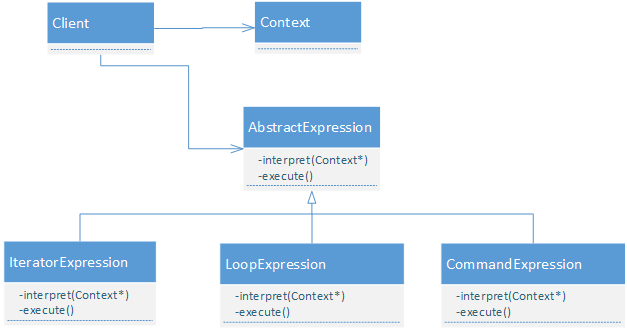定义

![]()

![]()
给定一个语言, 定于它的文法,并定义一个解释器,这个解释器使用改表示来解释语言中的句子。
类型
行为型模式
案例
像非常熟知的正则表达式就是描述字符串模式的一种标准语言,它为每一个模式都构造了一个特定的算法。

AbstractExpression - 一个抽象的解释操作,这个接口为抽象语法树中所有的节点所共享。
TerminalExpression - 终结符表达式,实现与文法中的终结符相关联的解释操作。
NonterminalExpression - 非终结符表达式,对文法中每一条规则R1R2...Rn都需要一个NonterminalExpressoin。
Context - 上下文,包含解释器之外的一些全局信息。
比如现在有一些表达式:
PRINT MyLanguage: NEXTLINELOOP 2PRINT Hello SPACEPRINT world!NEXTLINE- BREAK
- END
要解释这些语句,我们先用Context把他们分成一个一个的单词,然后通过IteratorExpression遍历这个Context得到每一个字符,然后调用具体的解释器进行解释,比如LoopExpression, CommandExpression,其中IteratorExpression和LoopExpression是非终结符表达式,CommandExpression四终结符表达式:

Context类进行输入字符串的分解,并能获取单一表达式:
class Context {public:Context(const string str){m_size = splitStr(str, m_strs);}string current(){return m_strs[m_size];}string next(){return m_strs[++m_size];}private:vector<string> m_strs;int m_size;}
AbstractExpression定义了一个统一的接口:
class AbstractExpression {public:virtual void interpret(Context* context) = 0;virtual void execute() = 0;}
在IteratorExpression中进行Context中字符串的遍历,并分配合适的解释器:
class IteratorExpression : public AbstractExpression {public:virtual void interpret(Context* context);virtual void execute();private:vector<AbstractExpression*> m_exps;}void IteratorExpression::interpret(Context* context){while(context->current() != "END"){if(context->current() == "LOOP"){LoopExpression* loopExp = new LoopExpression(context);m_exp.insert(loopExp);}else{CommandExpresion* cmdExp = new CommandExpression(context);m_exps.insert(cmdExp);}}}void IteratorExpresion::execute(){for(int i = 0; i < m_str.size(); ++i)m_exps[i]->execute();}
在LoopExpression中处理LOOP和BREAK之间的内容,并分配合适的解释器:
class LoopExpression : public AbstractExpresion{public:virtual void interpret(Context* context);virtual void execute();private:vector<AbstractExpression*> m_exps;int m_count;}void LoopExpression::interpret(Context* context){while(context->current() != "BREAK"){if(context->current() == "LOOP"){m_count = context->next().toInt();}else{CommandExpresion* cmdExp = new CommandExpression(context);m_exps.insert(cmdExp);}}}void LoopExpression::execute(){for(int i = 0; i < m_count; ++i)for(int j = 0; j < m_exps.size(); ++j)m_exps[j]->execute();}
在CommandExpression中决定具体解释操作:
class CommandExpression : public AbstractExpression{public:virtual void interpret(Context* context);virtual void execute();private:string m_name;string m_text;}void CommandExpression::interpret(Context* context){m_name = context->current();if(context->current() == "PRINT"){m_text = context->next();}context->next();}void CommandExpression::execute(){if(m_name == "PRINT")cout << m_text;else if(m_name == "NEXTLINE")cout << endl;else if(m_name == "SPACE")cout << " ";}
有了以上对类的定义,就可以输出我们想要的结果了
string str = "PRINT MyLanguage: NEXTLINE LOOP 2 PRINT Hello SPACE PRINT world! NEXTLINE BREAK END";Context* context = new Context(str);IteratorExpression* iterExp = new IteratorExpression();iterExp->interpret(context);iterExp->execute();
结果:
MyLauguage:Hello world!Hello world!






















 495
495











 被折叠的 条评论
为什么被折叠?
被折叠的 条评论
为什么被折叠?








